-
Posts
14,343 -
Joined
-
Last visited
-
Days Won
25
Content Type
Profiles
Forums
Blogs
Gallery
Events
Store
Posts posted by Ed_Haynes
-
-
Aren't we making a mistake expecting too much standardization in these ribbon bars? They are lovely things, to be sure, but aren't they ultimately all just the products of the fertile imaginations of inter-war European jewelers, producing entirely unofficial things that would sell to veterans, representing awards from defunct states.
Just a stupid question from an outsider.
0 -
Hi Ed, are there other medals to non-British forces like these??
Sorry, I may be dense, but I'm not quite sure what your question is.
These medals were awarded as the third of the great retrospective series of campaign medals for early campaigns, the first two being issued by the Crown (Naval General Service Medal and Military General Service Medal, for the wars against Napoleon, mostly) and this by the East India Company (at Wellington's insistence) to both Natives (of the British Isles) and Indians who were alive and who could be found who had served in these various campaigns. This broke the earlier pattern (already "softened" by the medal issued by the company for the First Sikh War) of "one campaign/one medal" and set a "general service medal" pattern which more or less continues until the present day (though more so in Pakistan than in India).
If you are asking whether medals were issued by non-Company forces, by their opponents, the answer is "probably not", though there are tantalising hints in the records of Maratha medals. THere were Sikh orders and medals, but not for services against the British (apparently).
Am I even close to answering your question?
1 -
Interesting . . . let me dig out my correspondence with Souval.
0 -
Thanks, Gordon,
Do you see this as a Souval restrike or an original?
Ed
0 -
Have been trying to find scanner settings for scanning color stuff in B/W that replicates the weird shifts you get in pre-1960s B/W film emulsions. Any expert opinions?
I know the "airplane boys" have done a lot with WWI-era photos, but they have the extra problem of having had aerial recon film used for snaps of their planes.
0 -
But those quirky spectrum shifts will throw a lot of things off.
0 -
At least with her name and the Ukaz date you can find out for certain what she got it for. It may be for something more exciting than milking cows... perhaps teaching ballet or the opera perhaps?
Dave
Aah . . . but which makes the greater contribution to Socialist Progress of the Motherland?
0 -
What is wrong with milking cows?!

Isn't that better (and more interesting) than years of valliant desk-sitting in some military
orificeoffice?0 -
-
Way (WAY) outside my interests, but a really (REALLY) nice site. Thanks!
0 -
And so many of these pre-1960 black and white films have such strange rendering of colors that there is often a challenge determining what is shown.
0 -
Igor now has the Battushig book listed again, if anyone is interested.
I am trying to establish contact with Dr. Battushig and will advise the forum of my success (or not). May try to visit him this summer.
0 -
Wonderful, Dave!

I'd have liked to have adopted that one! Would have given it a good and loving home . . . .
0 -
Interesting Ed, you dont see the stars named very often. I have one Africa Star named, but that's it. Could you show a reverse shot of this group? Thanks.
Normally, WWII medals (maybe 80% of them) to Indians (in the post-1947 meaning) are named. Pakistan named none, opening wonderful opportunities for the fakers of groups to flourish. It isn't widely known, I guess, that Indian WWII groups, while uncommon all-named, are even more uncommon all-unnamed (and, for this, there is usually a reason and a pattern). As I say, maybe 80% of medals in legitimate groups are named.
With one major project out of the way, finishing a detailed study of WWII Indian naming patterns is next on my agenda.
A sample (enhanced for legibility).
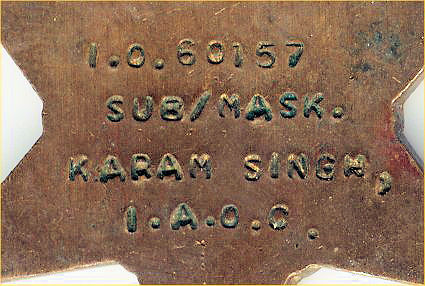
 1
1 -
One final one for now. I really don't want to flood the thread with Asian "exotica".
9-
IEC-8879 Lieutenant-Colonel Thakur Hanuman Singh Rajputana States' Forces (Kachhawa Horse and Jaipur Pony Company, Jaipur State Forces)
(Sorry for the naked Jubilee medal, it is dressed now but this is the only scan I could locate.)
entered service 1 Nov 1926
commissioned 25 Jul 1928
Lieutenant ???
Captain ???
Major 25 Jul 1940
Qualified in small arms
Senior Officers School (Indian States Forces)
Field Works Course (All Arms), Indian States Forces
Qualified at the Equitation School, Saugour
MBE by Gazette of India, 106-H, 13 April 1946, pt. 1, sect. 1, p. 530 (alphabetized under the "T"), repeating Supplement to the London Gazette 37433 of 17 January 1946: "for gallant and distinguished services in Burma", M.B.E. to "Major (temporary) Thakur Hanuman Singh (8879), Indian State Forces"
WO 373/81:
?ARAKAN
?During the period 16 Feb - 15 May 45 this unit has performed outstandingly and kept up a high standard of fitness and performance. This has been largely due to the drive and energy of Maj HANUMAN SINGH, who although he has been in command since 1940, has been on active service continuously since 1942, has succeeded in maintaining the high traditions of his unit.
?is long and devoted service, and the fact that he has kept up such a high standard for such a long period - including three continuous monsoons in very bad country - deserve recognition.?
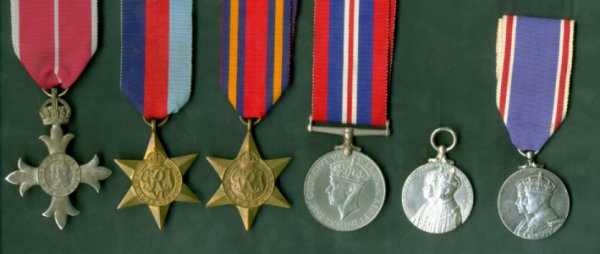
 1
1 -
I am trying to restrict these postings to things I haven't put up elsewhere on this forum. Hope I am successful.
8-
Colonel Daud Khan, Sardar Bahadur, Alwar Imperial Service Infantry
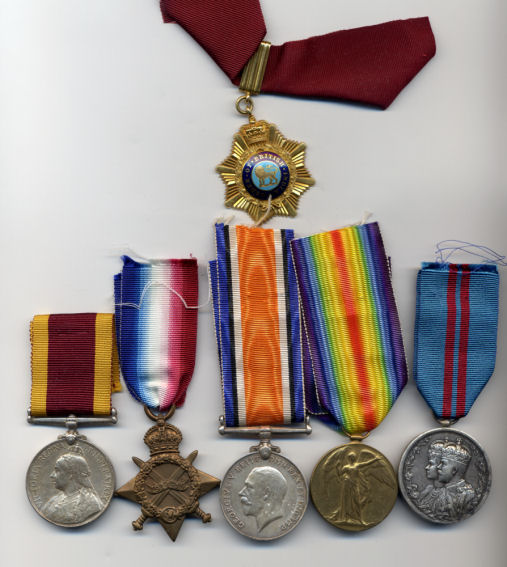
 1
1 -
7-
One that has been the subject of some research back-and-forth.
Lieutenant (S) P. G. Gokhale, Royal Indian Navy
1- Burma Star - unnamed, "restoration"
2- WWII War Medal - "LT.(S) P.G. GOKHALE, R.I.N.V.R."
3- Naval General Service Medal - George VI, 2nd variety - MINESWEEPING 1945-51 - "LT. (S) P.G. GOKHALE, R.I.N."
Shown in WWII Official History (p. 370) as serving in Burma Operations in the H.M.I.S. Rohilkhand (minesweeper). He was (apparently) commissioned 26 May 1945 (too late for Atlantic Star service and maybe too late for other qualifications?). The Royal Indian Navy were involved in minesweeping operations in the Malacca Straits commencing 2 September 1945. This included the 37th Mine Sweeping Flotilla consisting of nine minesweepers including the Rohilkhand, completing operations there by 13 November 1945. They then left Singapore and were involved in various other operations until the end of the year.
The Rohilkhand survived into the independent Indian Navy but had to be scrapped in 1956 after the 1948 cyclone that hit Bombay.
Much research awaits.
The group originally came with 1939-45 and Burma Stars (though it had first appeared on the market as just the last two medals). Increasingly, Gokhale's stars are appearing to be "restorations", though he was apparently qualified for the Burma Star, but not the 1939-45 Star. Need to check Indian Navy Lists.
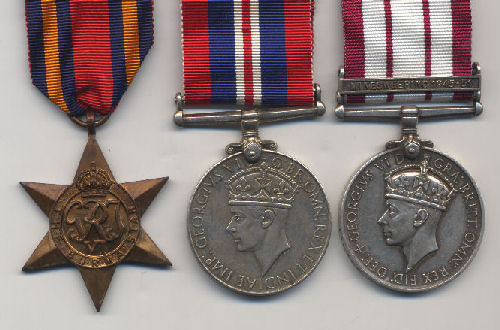
 1
1 -
OK, a few more.
6-
An odd group.
9347 Sepoy Bakshi Singh, Frontier Force Rifles
1- 1939-45 Star - 9347 SEP. BAKSHI SINGH, F. F. RIF.
2- Africa Star - 9347 SEP. BAKSHI RAM, F. F. RIF.
3- War Medal - 9347 SEP. BAKSHI SINGH, F.F. RIF.
4- India Service Medal - 9347 SEP. BAKSHI SINGH, F.F. RIF.
He must have qualified for the ISM before going to Africa, as a Defence Medal would be a more common pairing here.
A nice all-named Indian WWII group, though.
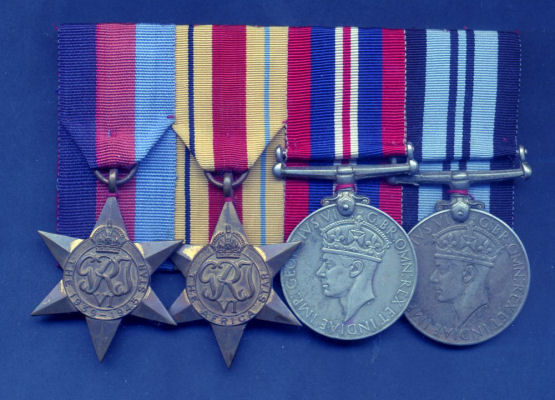
 1
1 -
Miscellaneous things:
1- Those three tricky Polar Stars:
#822 = 23 September 1936 (EH Group 1)As I read Battushig and reconcile it with Eric's list, this would have been Schena Type 1 (Battushig A31), the double red banner type, 1936-40.
#1,956 = 29 Novenber 1955 (yes, this and #2,705 ARE correctly if inexploicably dated) (EH Group 1)As I read Battushig and reconcile it with Eric's list, this would have been Schena Type 3 (Battushig A32.2), with Cyrillic legend (1941-70).
#2,705 = 8 Decmebr 1948 (yes, this and #1,956 ARE correctly if inexplicably dated) (EH Group 1)Same as above? Or was this a late Schena Type 2.2 award?! Battushig shows his A32.1 (Mongol legend) as 1940-41 and A32.2 (Cyrillic) as 1941-70, but . . .?
Now, more than ever, I wish Suuigiyn Gombo's Polar Stars were still with his group!

2- My other (single) RBL (shown as http://gmic.co.uk/index.php?showtopic=2499&st=19 in the "Mongolian Awards" thread) is #484 and is Eric's Type 1.
3- The numbering on my three Honorary Medal(s) of Labor:
No. 550 (Schena Type 1, Battushig ??)
3842 (Schena Type 1.2, Battushig A38.1)
18531 (Schena 2.1, Battushig A38.2)
Shown below.
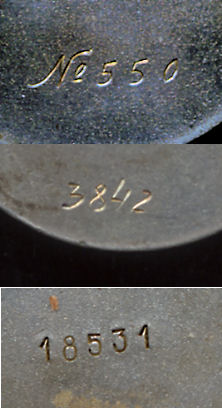
 0
0 -
Add to Rick's list:
Hero of Labor "Gold Soyombo" Medal (type 1) -- #52, 28 November 1962 (EH Group 1)
0 -
Great stuff, Eric. Thanks. Let us see what we can add . . . .
Maybe when we have dates on known serial numbers, more blankc can be filled in the gaping holes in our knowledge.
0 -
You mean the medals OR the grouping of them are widely faked?
Well, mainly groups. As the medals are unnamed, and the fakers in Islamabad have sacks of them, no reason to fake the medals: just one from sack 1, one from sack 4, one from sack, 3, add a named Pakistan Medal 1947, . . . !
0 -
5-
OK, I lied.
A group I paid far FAR too much for, but Indian WWI trios have been exceedingly rare until the last year or so. (A long story here.)
Trio to 3060 Naik Muhammad Sharif, 104th Rifles.
He turned out to be a Kut POW and probably MiD. As a Muslim, it seems likely that not much was left of him by the time he was released., (While their British officers sat drinking wine on the Bosphorous with their poodles, Indian POWs from Kut has No Fun At All as guests of the Ottiomam Caliph and Emperor.)
(Lousy scan, will do better if I am allowed to edit this when I can scan the real medals in hand.)
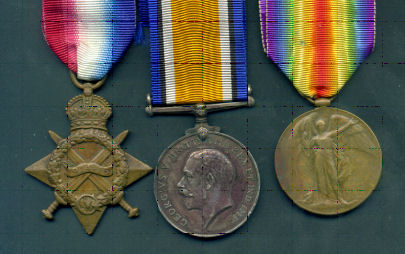
 1
1 -
4-
OK, one more before calling it "quits" for the night.
As Pakistani WWII medals were unnamed (shame) and as they are widely widely faked (double shame), I cannot guarantee the authenticity of this group, though my "gut" says it is "OK".
PAK/200043 AC2 MOHD SAFDAR. R.P.A.F.
1- General Service Medal: Kashmir 1948
2- Independence Medal
3- 1939-45 Star
4- WWII War Medal
5- Indian Service Medal
Only the Independence Medal is named, as shown above. He must have left by 1956, or there would have been a Republic Medal. Original ragged mounting.
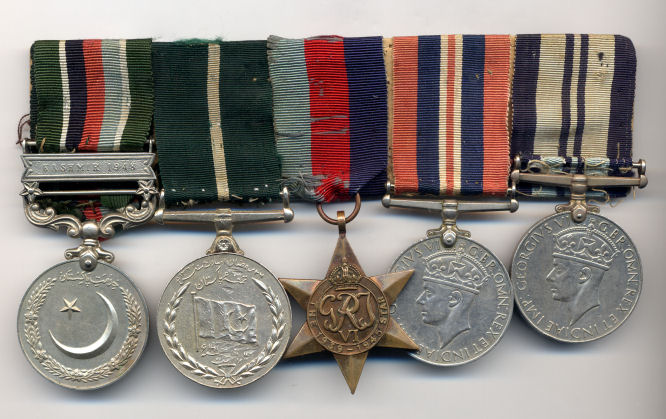
 1
1





Army of India Medals
in Great Britain: Orders, Gallantry, Campaign Medals
Posted
Oh . . . good question. (And I fully understand the pitfalls of writing late-evening or early-morning!)
You are creating a monster. I shall answer this in another thread. Hold on tight . . . .